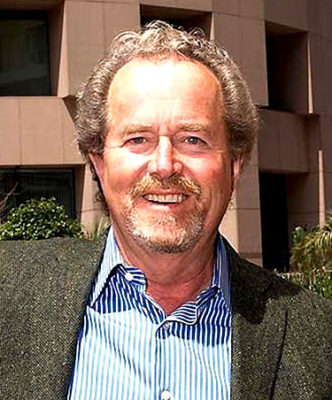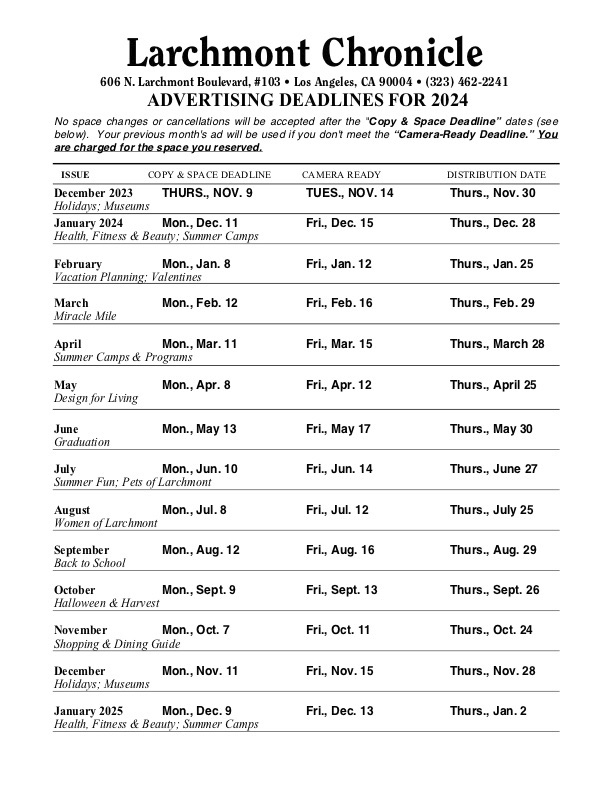Hancock Park leader Leonard Hill dead at 68

LEONARD F. HILL was a leader in many neighborhoods. Photo by Leonard Auslender.
The squire of the landmark La Casa de las Campanas (House of the Bells) on N. June St. and a leader in the national movement to protect the zoning of single-family neighborhoods, Leonard F. Hill, died peacefully at his home on June 7.
A resident of Hancock Park since 1986, Leonard Hill long had a commitment to preserving residential neighborhoods and historic buildings. Born and raised in Los Angeles, Hill was a Lifetime Cornerstone Member of the Los Angeles Conservancy and served two terms on its board of directors. He liked to tell the story of how he recruited Diane Keaton to the Conservancy’s membership ranks. As recounted in a 2005 article in the “Los Angeles Times”:
“Before Brad Pitt apprenticed with Frank Gehry and Hayden Christensen said he was interested in studying architecture, TV producer Leonard Hill unwittingly sparked a trend.
“It started with an offer to Diane Keaton. The actress, a devotee of architecture, wanted to see inside Hill’s Hancock Park home, a 1927 Spanish Revival that she calls ‘a supremely beautiful house’ designed by Lester G. Scherer.”
According to Keaton, “Len said, ‘I’ll give you a tour if you promise to join the L.A. Conservancy.’”
She did and he did.
In subsequent years, Keaton has become a stalwart member of both the Conservancy’s board and that of the National Trust for Historic Preservation. Hill said in the 2005 “Times” interview: “What Keaton did was to really get involved with the Conservancy. She’s not just a member but an activist.” In the interview, he noted that he had given much money and time to the Conservancy, but “the most important thing I will have left them is Diane’s legacy.”
Conservancy president Linda Dishman believes that Hill’s benefit to the Conservancy is far greater. She said of him: “Len Hill was a passionate preservationist. He believed in the value and power of historic places and was an incredibly articulate spokesperson for the cause. On a personal level, Len took great joy in his historic home in Hancock Park — the fabulous Casa de las Campanas — and worked with neighbors to get Hancock Park designated a Historic Preservation Overlay Zone (HPOZ).
“In the six years that Len served on the Los Angeles Conservancy board of directors, he was usually the strongest and loudest advocate in a room full of ardent preservationists. My favorite memories of him were during the fight to save St. Vibiana Cathedral from demolition. He was there at every step, from defending the preservation position at the “LA Times” editorial board to grabbing the laptop at a board meeting to draft our statement. We were always stronger with Len on our side and we will miss him.”

LA CASA DE LAS CAMPANAS in Hancock Park, restored by Len Hill, received many accolades. Photo by M2A Architects.
Hill’s home received the Windsor Square-Hancock Park Historical Society’s Landmark Award #3 in 1978, the first year such awards were bestowed. In 1981, La Casa de las Campanas became City of Los Angeles Historic-Cultural Monument #239. It is a large house with 37 rooms on a double lot overlooking the Wilshire Country Club. The original owner’s daughter, Lucille Mead Lamb, guided architect Scherer in creating the multi-level house with its three-story bell tower containing four large bells.
Hill’s interest in preserving residential neighborhoods led him to become a founding member of a nonprofit organization of concerned citizens devoted to the protection of those portions of our cities dedicated to single-family homes. Margo Leonetti O’Connell of Hancock Park said of Hill: “Len was co-founder and president of LRNA (League of Residential Neighborhood Advocates) for more than 10 years until he was first diagnosed with cancer. He was one of the most articulate men I know. He could explain an issue and his point of view succinctly and clearly so you could understand. He was a man of principle and thought everyone, no matter your creed, should abide by the rules.”
A native Angeleno, Leonard Franklin Hill was born on October 11, 1947, at Cedars of Lebanon Hospital, the son of Herbert and Edith Hill. A 1965 graduate of University High School, Hill received his B.A. (summa cum laude and Phi Beta Kappa) from Yale University in 1969, followed by a Master of Arts degree in education and history from Stanford.
Television producer
Hill broke into the entertainment industry right after college in 1971 with a summer job at Universal TV. He met a mentor and friend, writer Stephen J. Cannell, and that led to Hill writing episodes for the Jack Webb-created television series “Adam-12.” That was followed by executive jobs at Universal, Paramount and MTM. Hill then joined NBC as an executive in the dramatic series department. From 1977 until 1980, he served as Vice President of Movies for ABC before venturing into independent television production. Among the critically acclaimed movies produced during his administration at ABC were “The Jericho Mile,” “Amber Waves,” “Friendly Fire,” “Elvis” and “The Minnesota Strip.”
In 1980, Hill embarked upon his career as an independent television producer. His company was Leonard Hill Films (LHF), and it provided high quality, primetime filmed entertainment to the major broadcast networks. Through LHF, he produced more than 50 network television movies, four mini-series, and three dramatic series. Among the movies that LHF produced were “Mae West,” “The Long Hot Summer,” “Nitti: The Enforcer,” “In The Deep Woods,” “A Matter of Justice,” “The Last Fling” and “Prince of Bel Air.”
Seeing changes in the television business, Hill in 1988 founded and chaired the independent television distribution company Allied Communications Inc. (ACI). The company gathered together a number of independent producers (Avnet / Kerner, The Steve Tisch Company, Jaffe / Braunstein, Robert Greenwald, Von Zerneck / Sertner, and Konigsberg / Sanitsky) into a highly successful enterprise that was sold to Pearson, Plc. in 1994.
Hancock Park and Ojai resident, Jamie Bennett, said of Hill in those years: “Len created the company/consortium, ACI, from his TV producer peers . . . an amazing feat to bring together eight alpha male competitors into a common cause. They struggled with Len, the first among equals and the smartest guy in the room . . . lovingly referring to him as the company’s George Washington . . . its founder. As chair he was my boss for five years, a demanding boss . . . but very loyal and generous. We traveled internationally and had great fun together on those trips. I will miss him . . . he was a great teacher.”
The Turner Classic Movies website biography of Hill says of him: “Although few of Hill’s projects have been touted by the press as ‘prestige,’ his works have been well-produced entertainment fare and some of them have been standards of the genre, such as the biographical film ‘Mae West’ (ABC, 1982), starring Ann Jillian, and the miniseries ‘The Long Hot Summer’ (NBC, 1985), which earned Hill an Emmy nomination.”
In 1993, Hill partnered with a longtime colleague, Joel Fields, forming Hill/Fields Entertainment. They produced “A Matter of Justice” (NBC, 1993) with Patty Duke, and “Detention: Siege at Johnson High” (ABC, 1997) in which Ricky Schroder played a disturbed young man who holds the students of a high school as hostages.
Hill’s television production offices for many years were on Larchmont Blvd. and, later, in a building he purchased on Wilshire Blvd. at the entrance to Fremont Place.
Real estate developer
In 2001, Hill made a career change. He and Yuval Bar-Zemer joined with Arts District pioneer Paul Solomon, who had formed Linear City, a real estate redevelopment company. Focused on the adaptive repurposing of underutilized commercial buildings into architecturally distinctive mixed-use lofts, Linear City won numerous awards for projects such as the Biscuit Company Lofts, The Toy Factory Lofts, Seventh + Bridge, the Traction Lofts and The Elysian.
Rob Eshman, publisher and editor-in-chief of the “Jewish Journal,” wrote of the Linear City partners in 2012: “I spent the afternoon with Bar-Zemer and Hill, gazing out across the city from Bar-Zemer’s rooftop garden, eating at a recently opened Daily Dose cafe by some reclaimed railroad tracks, walking with Hill through the large empty spaces that would be two new restaurants, and ending, finally, at the EV charging station to juice up my Leaf. ‘We see ourselves as pioneers,’ Hill told me. ‘And this is the new frontier.’”
The day after Hill died, Bar-Zemer reminisced about his late business partner: “It was in early 2002 when I first met Len in his beautiful office at 4500 Wilshire. Len, sitting behind a beautifully carved desk with a pipe dangling from his mouth, wasted no time in explaining to me his view on the importance of adhering to a budget. The examples he used were all taken from the movie making world (which I had no idea about) but I very quickly declared that I do not tolerate budget overruns on my construction projects and thus started the beautiful partnership of Linear City.
“An unexpected combination of personalities allowed us to take some daring steps that have dramatically transformed the Arts District of Los Angeles from a derelict industrial neighborhood to one of the most vibrant and desirable places in our city. Len, with a rare combination of making smart business decisions, great eye for design, uncompromised trust in me and my teams and above all a sense of fairness and honesty, allowed our company to leave a print on the built environment that improved people’s quality of life, renewed our optimism about the future of Los Angeles and started a real economic engine that did not exist before.”
A film producer again
That involvement in the Arts District led Hill back to film production a decade after he became a real estate developer. As described in a February 2013 article in the “Los Angeles Times,” Hill was having lunch at the restaurant, Church and State, on the ground floor of his and Bar-Zemer’s Biscuit Company Lofts building in the Arts District, “ . . . when he spotted an old colleague, screenwriter Wendy Kout.” She had worked with Hill years before, but has transitioned her life to the theater, becoming a playwright.
The “Times” story told how Hill “gave Kout a tour of the lofts and a run-down area along Industrial Street that he and his partner had redeveloped. Kout, who lives in Sherman Oaks, was struck by the theme of transformation, both of a downtown she never knew existed and of Hill’s own post-Hollywood career.
“When Hill suggested they might work together again, a light went on in her head.”
Kout said “Here we are two repurposed people looking at this repurposed downtown . . . wouldn’t that be a great idea for a film?” Kout said that Hill replied, “You write it and I’ll produce it.” And that is what they did.
The result was the 2011 independent feature, “Dorfman in Love,” described by the “Times” as “a romantic comedy about a young suburbanite whose life is transformed when she leaves a dreary existence taking care of her father in the San Fernando Valley and moves into a downtown loft to cat-sit for a friend.” The film won a Hollywood Film Award the year it was released.
A final project
A lengthy piece in “The Planning Report” in July, 2014, described Hill’s final Linear City project with Bar-Zemer, the re-purposing of the former Metropolitan Water District headquarters on Sunset Blvd, designed in 1960 by former Hancock Park resident and architect, William L. Pereira, FAIA.
Renamed The Elysian and now full of apartment tenants, Hill said of that and his other projects and of his city in 2014:
“I’m very proud of what Linear City has accomplished. We’ve taken what was seen 15 years ago as a blighted part of town and turned it into a blossoming neighborhood filled with restaurants, cafes, coffee houses, and a vibrant street life.”
Hill continued in his “Planning Report” interview: “It’s been a remarkably gratifying process — not just a profitable one. The significant reward I’ve received from the Linear City partnership goes beyond the return on initial investment: It’s the sense of pride. We’ve created a legacy that is manifest in the transformation of blight into beauty, of neglect into neighborhood.”
Board member, philanthropist
Perhaps it is the word “neighborhood” for which Len Hill will be most remembered.
Hill’s “neighborhood” is not just Hancock Park and environs, but the Arts District and the city as a whole. Reported widely in March of 2016 was what the “Los Angeles Downtown News” titled its story: “Leonard Hill’s Good Deed.” The “Downtown News” said:
“Hill’s latest move goes beyond housing. [He] is personally paying for a new Arts District art park. It will be a public amenity that comes online around the time the Sixth Street Viaduct replacement opens in 2019.
“Hill has donated $1.9 million, which will cover the creation of the 1.4-acre project with a stage, as well as three years of programming. Design details are still being worked out. The mechanism was the Mayor’s Fund for Los Angeles, a program started by Mayor Eric Garcetti to allow individuals to donate to efforts that will make the city a better place.”
Hill told the “Downtown News”: “I hope to give back to the city that gave me so much.”
Before he died, in addition to funding what will become the Leonard Hill Arts Park, Hill established the Leonard Hill Foundation that will provide grants to benefit less fortunate people in Los Angeles. These grants are expected to equal about $40 million in coming years.
Not only was Hill the leader of the League of Residential Neighborhood Advocates and a board member of the Los Angeles Conservancy, he also served on the boards of the California Film Commission, Common Cause, and the Caucus of Producers, Writers and Directors.
Hill was divorced from his first wife, former television producer Ann Daniel. He continued to reside in La Casa de las Campanas with his second wife, Patricia Gordon, MD. Dr. Gordon is a board-certified radiation oncologist who left her private practice in 2014 to found and direct CureCervicalCancer (CCC), a nonprofit organization dedicated to the early detection and prevention of cervical cancer in developing countries.
Dr. Gordon brought her three children, Lindsey, Allie, and Ben, as well as Lindsey’s husband Rick and Allie’s husband Jeremy, into the marriage, and Hill proudly called them all his own. More recently, Hill took up grand-parenting of Tessa and Annie. Hill also is survived by his brothers, Andrew and Richard and their families.
Services were held at Hillside Memorial Park, and the family indicates that gifts in lieu of flowers may be sent to “Violence Intervention Program of the S. Mark Taper Family Advocacy Center” violenceinterventionprogram.org/leonardhill or “J Street” jstreet.org/donate “in honor of Leonard Hill.”
Dr. Gordon said of her husband the morning that he died: “What I believe Len would like to leave behind for us is a lesson in our ability to embrace change. I think he would want all of us to take this moment in our lives to claim our future in such a way that it enriches other’s lives. This is the charge he has given to me and to so many of you.”
UPDATE: This article was updated with additional detail on June 10 at 10:17 a.m, and to clarify Paul Solomon’s pioneering role in establishing Linear City on June 14 at 11:08 a.m.
Category: News


